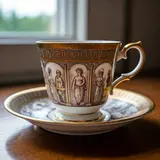
The Duchess of Bedford’s Delight: The Evolution of Afternoon Tea

Afternoon tea owes its existence to Anna, the 7th Duchess of Bedford. Feeling a dip in energy in the late afternoon, she began requesting a light meal and tea. This personal indulgence soon blossomed into a social gathering, as she invited friends to join her for the afternoon. An early 20th-century guide explains the basics:
THE AFTERNOON TEA is perhaps the most popular of social functions, and deservedly so, since it is essentially of the utmost simplicity, yet may be expanded into a most elaborate social affair. In the original simple form, the hostess merely welcomes her guests as they come to her on her regular day at home, in the drawing-room, and there offers them a cup of tea served by herself and light refreshments of sandwiches and cakes and the like.
The next development in the tea is in the nature of a small afternoon reception, or at home. For this occasion, the hostess issues invitations a week in advance. A visiting-card serves the purpose, with a line written below the name: “Wednesday, June fourth, from four until seven o’clock.” If there is to be a guest of honor, an additional line may indicate the fact: “To meet _____.”
The procedure for the hostess at a function of this sort is more formal. It is usual to have the refreshments in the dining-room, though they should not be of an elaborate character. The teapot is placed at one end of the table, and presided over by some friend, since the obligations of the hostess prevent her rendering this hospitable service in person.
Afternoon tea is a versatile social event, ranging from a simple gathering to an elaborate affair. In its simplest form, the hostess greets guests in the living room on her regular day at home, offering tea and light refreshments like sandwiches and cakes. A more formal version, resembling a small reception, involves invitations sent a week in advance, often using a visiting card with the date and time noted. For these occasions, refreshments are typically served in the dining room, with a friend overseeing the teapot, as the hostess is occupied with other responsibilities.
These instructions can be found in the guide, Etiquette Made Easy, published in 1919.